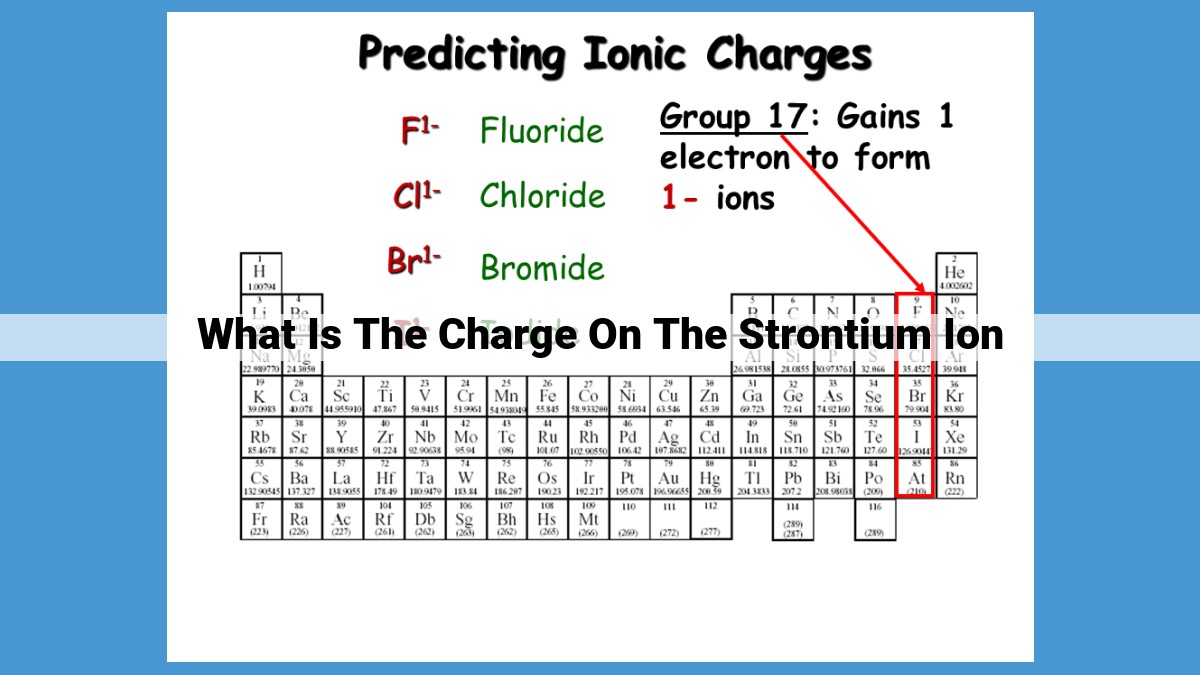The strontium ion has a charge of +2. Strontium is an alkaline earth metal with a valence of +2, meaning it has two valence electrons in its outermost energy level. When a strontium atom loses these two electrons, it becomes a positively charged ion called a strontium ion. The loss of electrons results in a net positive charge of +2 on the ion, following the principles of electrochemistry where cations (positively charged ions) are formed by the loss of electrons.
Exploring the Alkaline Earth Metals: Understanding Their Chemistry
Let’s embark on a journey into the fascinating world of alkaline earth metals, a group of elements with unique characteristics that have shaped various fields of science and technology.
These elements reside in Group 2 of the periodic table and share a distinguishing feature: they all have a valence of +2. This means that their atoms have two valence electrons, the electrons in their outermost energy level, eager to participate in chemical reactions.
Key Characteristics of Alkaline Earth Metals
Alkaline earth metals are highly reactive, readily forming compounds with other elements. They exhibit a strong metallic luster and are excellent conductors of heat and electricity. Their low ionization energies make them easily oxidized, resulting in the formation of stable 2+ ions.
Valence and the Strontium Ion: Unveiling the Secrets of Strontium’s Charge
As we delve deeper into the fascinating world of alkaline earth metals, it’s time to shine a spotlight on valence, a fundamental concept that holds the key to understanding these elements’ behavior. Valence, my friends, refers to the outermost energy level electrons that eagerly participate in chemical reactions.
Picture strontium, an alkaline earth metal that stands out with a valence of +2. This means that strontium has two valence electrons yearning to engage with other elements. These two electrons are like tiny ambassadors, eagerly seeking to form bonds and create harmonious compounds.
However, the story doesn’t end there. To truly grasp strontium’s ionic charge, we need to unravel the intricate process of ion formation. Strontium’s journey towards becoming a positive cation unfolds as it willingly relinquishes its valence electrons. These electrons, like valiant knights, venture out into the world, leaving behind a positively charged strontium ion.
This loss of electrons leads us to a profound realization: the strontium ion proudly carries a charge of +2. This positive charge is a testament to the two electrons that embarked on their mission, leaving behind a strontium ion eager to form new connections.
Delving into the Formation of Strontium Ions: A Scientific Adventure
In the realm of elements, alkaline earth metals stand out for their unique properties and behavior. One of these elements is strontium, a fascinating subject that we’ll explore in this blog post.
Understanding Valence and Strontium’s Role
Valence, a key concept in chemistry, refers to the number of outermost energy level electrons in an atom. Alkaline earth metals, including strontium, have a valence of +2, meaning they have two valence electrons. These electrons play a crucial role in determining the chemical properties of an element.
The Birth of Strontium Ions
Atoms, in their quest for stability, often undergo transformations that alter their electron configuration. For strontium, this transformation involves the loss of its two valence electrons. This loss results in the creation of positive ions called strontium ions.
Imagine a strontium atom as a minuscule world, where electrons orbit around the nucleus like planets. When an atom loses electrons, it loses its negative charge and becomes positively charged. In the case of strontium, the loss of two electrons results in the creation of a strontium ion with a charge of +2.
The Power of Electrochemistry
The concept of ionic charge is rooted in the principles of electrochemistry. Cations are positively charged ions, like the strontium ion we’ve just discussed. By understanding the loss of valence electrons, we can confirm that the strontium ion indeed carries a charge of +2.
This understanding of strontium ions is not only intellectually fascinating but also crucial for comprehending the element’s behavior in chemical reactions and its multifaceted applications in science and technology.
Ionic Charge of Strontium: Exploring Electrochemistry
Electrochemistry, the realm where electrical forces dance with chemical substances, offers valuable insights into the ionic charge of strontium. Cations, defined as positively charged ions, take center stage in this electroconductive saga.
Strontium, our protagonist, readily sheds two valence electrons, leaving behind a positively charged ion. It’s like a tiny atom shedding its excess weight to find a balanced state. This loss of electrons transforms the neutral strontium atom into a strontium ion with a respectable +2 charge.
Electrochemistry lends its principles to understanding this charge transformation. The concept of oxidation explains how strontium atoms relinquish their valence electrons, creating a positive imbalance that manifests as the +2 charge. The presence of this charge confirms the strontium ion’s place as a cation.
Thus, the strontium ion’s positive charge is not merely a random occurrence but a consequence of its atomic structure and the fundamental principles of electrochemistry. By delving into these concepts, we gain a deeper comprehension of the intricate relationships that shape the chemical world.
